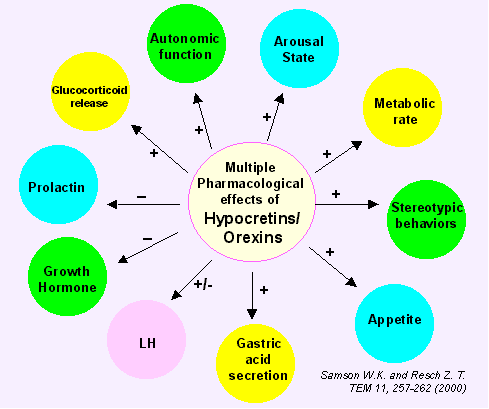Orexins and Animal Behavior
Biology 342 Fall 06
Website created by Emily Justusson, student at Reed College
Orexins and  Animal Behavior
Animal Behavior
What are orexins?
Orexin-A and orexin-B (also called hypocretin-1 and hypocretin-2) are two neuropeptide hormones that are formed from a common precursor in the hypothalamus. These hormones are then transported throughout many parts of the brain. There are two types of orexin receptor in the brain, one of which preferentially binds orexin-A, while the other binds both hormones equally well. Many behavioral effects are attributed to orexin-A but not orexin-B. These hormones are thought to help coordinate an animal's sleep-wake cycle with its metabolic activity and feeding behavior. Although other hormones also affect appetite, sleep, and arousal, orexins seem to play an important role in coordinating these systems. The disease narcolepsy is believed to be caused in mice, dogs, and humans by problems with either producing or recieving orexin. (Image source)Appetite
- Food consumption increases with injection of orexin-A, if given at times when when normal food intake is low.
- Fasting leads to increased levels of orexin.
- Drinking behavior increases with centrally injected orexins.
- Less food is consumed than normal with disfunctional orexin receptors.
- Spontaneous feeding in fasted rats decreases when anti-orexin antibodies are administered.
Reward
- Rats conditioned to expect a food or drug (but not other type of) reward have higher levels of orexin than rats that do not anticipate a reward.
- Conditioned rats no longer seek out food and drug rewards when an orexin agonist is administered.
- Reward-seeking behavior can be reinstated in rats by orexin injections.
Activity
- Mice who lack orexin become obese.
- Increased activity levels are correlated with increased orexin.
- Locomotor activity increases with injections of orexin.
- Activity reduces when orexin system is damaged.
- Narcoleptics- who have disfunctional orexin systems- can have episodes of cataplexy (spontaneous muscle atrophy during periods of excitement-- one of the symptoms of narcolepsy).
- Orexin levels increase in active waking over quiet waking, and are correlated with motor activity.
Sleep and Waking
- Narcolepsy, which includes daytime sleepiness, episodes of REM sleep during periods of wakefulness and waking episodes during sleep, is caused by inactive orexin pathways.
- Proportion of time spent in REM versus non-REM sleep changes in the absense of orexin.
- Wakefulness is correlated with increased orexin neuron activity.
- Sleep is correlated with reduced orexin neuron activity.
- Circadian rhythms may partially control orexin levels.
- Wakefulness in rodents dose-dependently increases with i.c.v. injections of orexin-A.
- Mice without orexin show less wakefulness in anticipation of feeding than mice with normal amounts of orexin.
top